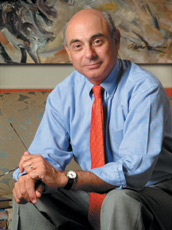Time served
It’s high time to change the structure of residencies
 Michael M.E. Johns is chancellor of Emory University after leading the university’s health sciences for more than 10 years. He was dean of the Johns Hopkins School of Medicine and vice president of the medical faculty. He is an otolaryngologist-head and neck surgeon. |
By Michael M. E. Johns
When I was a junior surgical resident some years ago, I was assisting my attending surgeon on an abdominal surgery. I had been on duty for hours, up all night, and my only job that morning was to hold the retractor. No big deal, I thought, I had been working the long-long shifts all year.
But I soon felt my eyes close, and my head started to drop. I jerked my head up and blinked my eyes several times, realizing that I was falling asleep. I wasn’t the doctor ultimately responsible for this patient, but what if I had been?
Most residents have experienced sleep deprivation to some degree. We have all heard the war stories—the one where a tired resident accidentally stuck her stethoscope in the refrigerator or the resident who couldn’t remember his spouse’s name—but behind those humorous tales are potentially serious consequences. We all know, and studies have shown, that residents who are sleep deprived and fatigued commit more medical errors, are more likely to incur needle stick injuries, and have a higher incidence of automobile accidents. As I look back, I should not have been in the operating room that day after a long shift without sleep for more than 24 hours, so I’m pleased to see the ACGME enact a 16-hour shift limit for first-year residents. (The ACGME does allow those in their second year of residency and beyond to work up to 24-hour shifts.)
The most common argument I hear against the new ACGME rules relates to the educational experience—longer shifts allow residents to follow patients for an extended time and experience continuity of care. Experience with continuity of care can be learned in daylight as well as in the middle of the night. The best way for interns and residents to learn medicine is to use their time wisely. I applaud the ACGME’s recommendations about duty hours, but the ACGME also promulgated many other requirements that go beyond duty hours and will not only assure the safety of residents and their patients but also will enhance the educational experience.
Now is the time to shift our attention to what I believe is the real issue at hand: what matters in residency training is not the hours worked but what residents do during those hours. Medicine has changed tremendously in the past decade, so an evaluation of how residencies are structured is long overdue. Residency education needs to focus on outcomes and competencies, not just time served. Residents should have time for meaningful clinical encounters, critical thinking, study, and reflection.
Over the years, we have successfully shortened patients’ length of hospital stays, but at the same time, our residents seem to be functioning as clinical service machines. They are admitting and managing the care of more and more patients, all the while keeping the clinical service covered and enhancing hospital “throughput.” A lone resident covering a couple dozen or so patients on the night shift is not what is best for patients or residents. More important, residents require adequate supervision based on their level of training.
One of the most significant changes to graduate medical education in the past several decades is the extensive proliferation of new subspecialties and with that, longer training time in almost every discipline. While this is a logical and justified response to the enormous and beneficial expansion of our medical knowledge and the development of new technologies, we must consider revising and shortening the time to complete that subspecialty training, not just pile years on. One approach is to shorten the time in core specialty training and track the resident into their subspecialty training sooner. This is already being done in several surgical disciplines and could be done across the board. We might start by asking what will the resident really be doing when they are in practice and develop the curriculum around that. Given the projected physician shortage and to say nothing of the large debt burden that so many of our medical students graduate with, we would be doing good for both society and the residents.
Most U.S. medical schools, like Emory, have done a good job of revising their curriculums using modern learning theory and technologies. New curriculums are more patient-centered and more nimble to address the ever-changing field of medicine. The naysayers are gone, and the new approaches are embraced by students and faculty. Medical educators now must turn their attention to the changes needed in graduate medical education. EM


